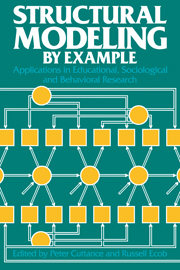Book contents
- Frontmatter
- Contents
- Preface
- List of contributors
- 1 Introduction
- 2 An overview of structural equation modeling
- 3 Field dependence and the differentiation of neurotic syndromes
- 4 High school seniors' reports of parental socioeconomic status: black–white differences
- 5 Modeling the hierarchical structure of learning
- 6 A study of longitudinal causal models comparing gain score analysis with structural equation approaches
- 7 Some structural equation models of sibling resemblance in educational attainment and occupational status
- 8 Applications of structural equation modeling to longitudinal educational data
- 9 The robustness of maximum likelihood estimation in structural equation models
- 10 An inquiry into the effects of outliers on estimates of a structural equation model of basic skills assessment
- 11 Testing structural equation models
- 12 LISREL models for inequality constraints in factor and regression analysis
- 13 Issues and problems in the application of structural equation models
- Appendix
- Glossary
- Index
10 - An inquiry into the effects of outliers on estimates of a structural equation model of basic skills assessment
Published online by Cambridge University Press: 12 January 2010
- Frontmatter
- Contents
- Preface
- List of contributors
- 1 Introduction
- 2 An overview of structural equation modeling
- 3 Field dependence and the differentiation of neurotic syndromes
- 4 High school seniors' reports of parental socioeconomic status: black–white differences
- 5 Modeling the hierarchical structure of learning
- 6 A study of longitudinal causal models comparing gain score analysis with structural equation approaches
- 7 Some structural equation models of sibling resemblance in educational attainment and occupational status
- 8 Applications of structural equation modeling to longitudinal educational data
- 9 The robustness of maximum likelihood estimation in structural equation models
- 10 An inquiry into the effects of outliers on estimates of a structural equation model of basic skills assessment
- 11 Testing structural equation models
- 12 LISREL models for inequality constraints in factor and regression analysis
- 13 Issues and problems in the application of structural equation models
- Appendix
- Glossary
- Index
Summary
Little is known about the behavior of LISREL estimates when distributions are contaminated by outlying observations. Monte Carlo approaches have typically been used to investigate the robustness of maximum likelihood techniques in factor analysis models (Fuller & Hemmerle 1966; Olsson 1979; Gallini & Mandeville 1984; Boomsma, Chapter 9 in this volume) or to examine departures from normality (Andrews, Gnanadesikan, & Warner 1973; Gnanadesikan 1977). Such studies have yielded important results concerning the robustness of maximum likelihood estimates under various conditions. However, the Monte Carlo approach is atypical of the situation faced by the practicing researcher dealing with a data set in which the “true” structure in the population is unknown.
In this chapter the influence of outliers on parameter estimates is addressed in a real data set. The LISREL model is examined using real data in which the relationships may be atypical owing to the influence of outliers. A robust estimation technique (Tukey 1960) is employed to identify outlying observations. The consequences for model fit in samples of variable sizes are examined when these outliers are removed from the sample. The major aim of the chapter is to provide the researcher with a practical strategy for the detection of outliers in the context of structural modeling and an indication of their effects on parameter estimates.
The model
In 1978 the South Carolina legislature established the Basic Skills Assessment Program (BSAP). The BSAP tests of reading and mathematics were field-tested in 1980 and administered statewide in the spring of 1981 (South Carolina Department of Education 1981).
- Type
- Chapter
- Information
- Structural Modeling by ExampleApplications in Educational, Sociological, and Behavioral Research, pp. 189 - 201Publisher: Cambridge University PressPrint publication year: 1988



